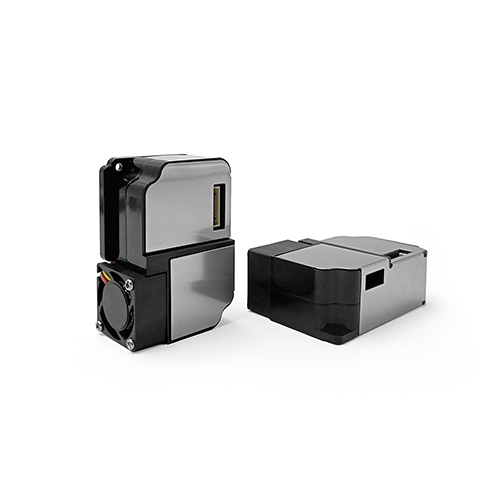Air particle monitoring sensor introduction and working principle
Particulate matter (“PM” for short) is a mixture of suspended solid particles and small liquid droplets that can be inhaled and can cause serious health problems.PM includes a wide variety of particles with varying characteristics (i.e., shape, optical properties, size, and composition), but is most commonly divided into subcategories based on particle size. The different categories of particulate matter are usually reported under the common nomenclature “PMx”, where “x” refers to the diameter of the largest particle in a mixture of suspended particles or “aerosols”. For example, PM2.5 typically refers to respirable particles 2.5 micrometers in diameter and smaller, PM10 refers to particles 10 micrometers in diameter and smaller, and so on. Historically, to assess the quality of the air we breathe, governments have identified specific particulate species, PM10 and PM2.5, as important indicators for monitoring. This is because PM10 particles irritate the mucous membranes of exposed organs such as the eyes and throat, and PM2.5 particles travel all the way through the lungs and into the alveoli. new particulate species such as PM1.0 and PM4.0 will also be included in the scope of air quality monitoring equipment. These new measurements will provide additional information to the traditional PM10 and PM2.5 metrics, allowing for better particle pollution analysis and the development of environmentally appropriate monitoring equipment based on the type of aerosol being detected (e.g., house dust vs. smoke).
Particle Size Ranges of Common Pollutants
The general definition of particulate matter includes particles up to 100 nanometers in size. Particles smaller than 100 nanometers are reported as “ultrafine particles” (or “UFPs”) and are not discussed here. Within this definition of particulate matter – which includes particles ranging in size from 0.1 to 10 microns – the smaller the particles, the deeper they can travel through our respiratory tract and into our bloodstream, posing a greater risk to our health. The World Health Organization (WHO) has reported suspended particulate matter (SPM) as a Class 1 carcinogen and the greatest environmental risk to human health, accounting for about 1 in 9 deaths each year.
Historically, PM values have been measured in terms of “mass concentration” (in μg/m3). The reason behind this is that traditionally the most accurate method of measuring PM is gravimetry. This measurement procedure uses pre-weighed filters to collect particles in the ambient environment that are pre-sorted by particle size (e.g. all particles smaller than 2.5 microns are allowed in). At the end of the sampling period (usually 24 hours), the filter is weighed and the total weight of the collected particles (in μg) is determined. The mass concentration (in μg/m3 ) is then obtained by dividing the filter mass gain by the total volume of air passing through the filter over the 24-hour period. Although gravimetry has long been recognized as the most accurate method of determining mass concentration, there are some limitations to the popularity of this method for everyday use, such as: the measurement instrument is bulky and expensive, it can only handle one PM particle size at a time (e.g. PM2.5), it does not allow for real-time sampling, and it does not allow for the output of particle counts.
As a result, real-time optical particle counters (OPCs) are gradually entering the air quality monitoring market. These instruments are based on different optical principles – usually scattering or absorption, with light scattering being the most common. In an OPC, particles are passed through a light source (usually a laser beam), which scatters (or absorbs) the incident light. The scattered light is then detected by a photodiode and converted into a real-time particle count and mass concentration value.
Currently, optical detection is the most widely used technique. This is due to the ease of use and unrivaled price/performance ratio. In recent years, OPC has been miniaturized enough to be integrated into air conditioning units, air quality monitors, and air purifiers, which can be used to regulate and control the quality of air in the home, car, and outdoor environments.
While the basic principles of OPCs may seem simple, not all OPCs work the same way from an implementation standpoint, and the air quality they measure is largely dependent on equipment engineering. Optical principles are very effective for counting particles, but such devices are primarily used to estimate particle mass concentrations and are prone to estimation errors due to the fact that particles have different optical properties (e.g., shape and color) and different mass densities. Therefore, mass estimation is highly dependent on the manufacturer’s algorithm for converting the measured optical signals into particle mass concentration. In addition, internal airflow engineering can have a significant impact on sensor accuracy and drift, as particles can easily accumulate on the optical components (lasers, photodiodes, beam traps), which, if not engineered correctly, can lead to a gradual degradation of component performance over time.
Fosensor Laser Particle Sensor FS00201 is a laser particle sensor developed by Fosensor in China. It is a digital general-purpose particle concentration sensor that utilizes the principle of light scattering for the detection of dust particles in the air, and is capable of accurately detecting the values of specific PM1.0, PM2.5, and PM10, with small size, high detection accuracy, good repeatability, and good consistency, It has the advantages of small size, high detection accuracy, good repeatability, good consistency, real-time response, continuous collection, strong anti-interference ability, 100% testing and calibration of the sensor, etc. It can be embedded into a variety of air particulate matter concentration related instruments and improvement equipment.







